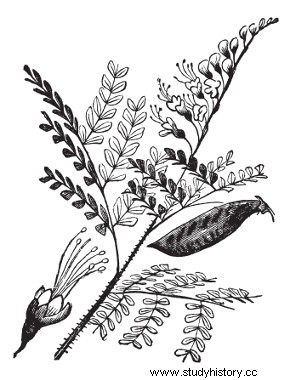
By Me. Cláudio Fernandes
The vegetable known as brazilwood It has also been called pau-de-Pernambuco, however, its scientific name is Caesalpinia echinata. It was often found in the Brazilian Atlantic Forest region, which stretched across swaths of land that stretched from states like Rio Grande do Norte to Rio de Janeiro. This tree has properties that made it the first really valuable product in the period when the Portuguese colonial system was set up.
As the researchers Francismar Aguiar and Reinaldo Pinho point out, on the “occasion of the discovery, a tree from whose wood was prepared a red dye used in dyeing was drawn to the attention of Portuguese navigators. of feathers. “Ibirapitanga ” was the name used by the natives, which means, in Tupi, red wood. This dye was immediately used by Europeans, replacing a similar one produced with “sappan” to dye fabrics.” (Aguiar, Fracismar F.; Pinho, Reinaldo. Pau-Brasil. Caesalpinia echinata. National tree. São Paulo, 2007. p. 16).
This property of reddish dyeing, associated with the usefulness that pau-brasil wood offered in the manufacture of musical instruments, furniture and other household items made of wood, resulted in the exploitation of this raw material in the early years of colonization. By 1503 there was already a complex system set up around the extraction of pau-brasil. The Portuguese metropolis granted the monopoly of timber extraction to private entrepreneurs, who were responsible for organizing themselves into trading posts, that is, sorts of fortified warehouses where the product was stored and from where it left to supply the ships that were destined for it. the Portuguese crown.
The work of extracting brazilwood was done with indigenous labor, obtained from the practice of barter, that is, the exchange of European goods and trinkets for heavy labor . The Indians were responsible for felling the wood, cutting it into logs, transporting it to the factories and accommodating them; in exchange, they received objects such as beads, fabrics, various clothing, pocketknives, knives and other such utensils. Between the years 1503 and 1505, the monopoly of pau-brasil was under the rule of Fernando de Noronha (the discoverer of the archipelago that bears his name) and his partners.
Researchers Francismar Aguiar and Reinaldo Pinho still remember that the Portuguese nau (vessel) that left Brazil in 1500 to give the King of Portugal, D. Manuel, the news of the discovery of the “island of Vera Cruz” “[…] carried logs of pau-brasil. In 1501, D. Manoel sent Captain André Gonçalves to study the usefulness of the new colony, but he was informed that there was nothing useful except a large amount of pau-brasil [...]”. However, in Pero Vaz de Caminha's letter, addressed to the king, there is no reference to wood.
